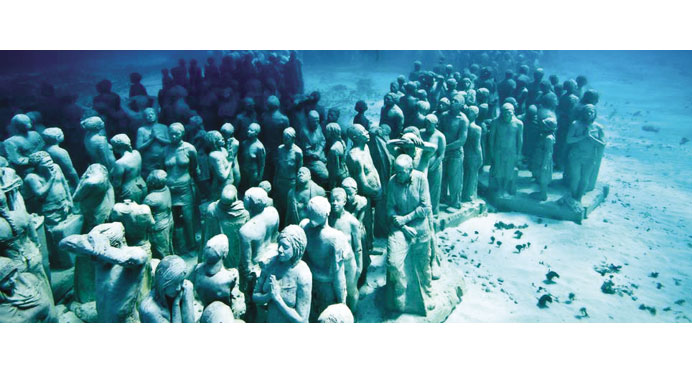What lies beneath: The Silent Evolution is a permanent monumental sculpture created by Jason deCaires Taylor on an artificial reef in Mexico. Occupying more than 420sqm and with a total weight of more than 200 tonnes, it consists of 400 life-size casts of individuals taken from a broad cross-section of humanity, and has been designed to aggregate fish and corals on a grand scale. It was the first endeavour of a new underwater museum called MUSA, Museo Subacuatico de Arte, a perfect day out for art lovers with flippers and snorkels.
By Charles Saatchi/London Evening Standard
Ever since Plato first described the city of Atlantis, occupying a region beneath the seas as large as Libya, scholars have scoffed that such an advanced civilisation has never been detected.
However, a wealth of human history has been recently discovered in our oceans, and technological innovations have led scientists to question theories accepted for decades, theories that are being undone with every new finding.
As an example, in the Bay of Cambay, India, remains were discovered of a 9,500-year-old city, intact with its architecture and human skeletons, pre-dating by 5,000 years any knowledge of civilisation in that area.
In Yonaguni-Jima, Japan, a diver discovered pyramids, carbon dated as thousands of years old, created off the coastline. The structures appear to have been carved out of bedrock in a terra-forming process using tools unavailable to cultures of the region.
A team of scientists continue to unravel megalithic ruins found in the Yucatá Channel between Mexico and Cuba.
They have created computer models of a mysterious underwater city, showing an extensive urban environment stretching for miles along the ocean floor, with evidence of civilisations that pre-date all known ancient cultures in that part of the world.
It may appear that we require the soundtrack to Twilight Zone to be playing in our heads as we read about Earth’s unexplained mysteries. But aren’t you rather invigorated by the knowledge that there are so many “known unknowns” still to be discovered on Earth, even now?
Alarmingly, cities in the present day may fall victim to the same demise as Atlantis.
Cracks in the road at the foot of the Shanghai Tower Project - a 632m-high structure due to be completed in 2015 - gave the citizens of Pudong cause for concern that the foundations of their city were shifting.
Shanghai has sunk 2.6m since 1921, with Le Monde reporting that a recent study by the Institute of Geology and Geophysics shows 50 fast-expanding cities are affected by this type of subsidence, mainly as a result of the excessive use of groundwater. The rise in demand is due to people migrating to the cities, and to changing patterns of consumption and industrial growth.
The Colosseum in Rome is approximately 15.5 inches lower on its south side than on its north. It is thought that vibrations from busy roads and a metro line close to the famous landmark are to blame. Luckily, there is a $30mn restoration project getting under way, due for completion this year.
Venice has a very well documented sinking problem; its foundations resting on millionns of wooden piles stacked into marshy ground have sunk by about seven centimetres a century for the past 1,000 years.
Venice is not alone. Other famous locations sinking lower each year are the island of Bora Bora and the Taj Mahal.
This sinking feeling hasn’t gone unnoticed by artists; Michael Pinsky has used lights on landmarks across London to show the predicted sea level of the city in the year 3111, demonstrating how much would be submerged in 1,000 years’ time.
His artwork may appear a little bleak and pessimistic to some viewers but particularly so to committed Global Warming deniers such as me.
*Charles Saatchi’s latest book is The Naked Eye, published by Booth-Clibborn Edition.

